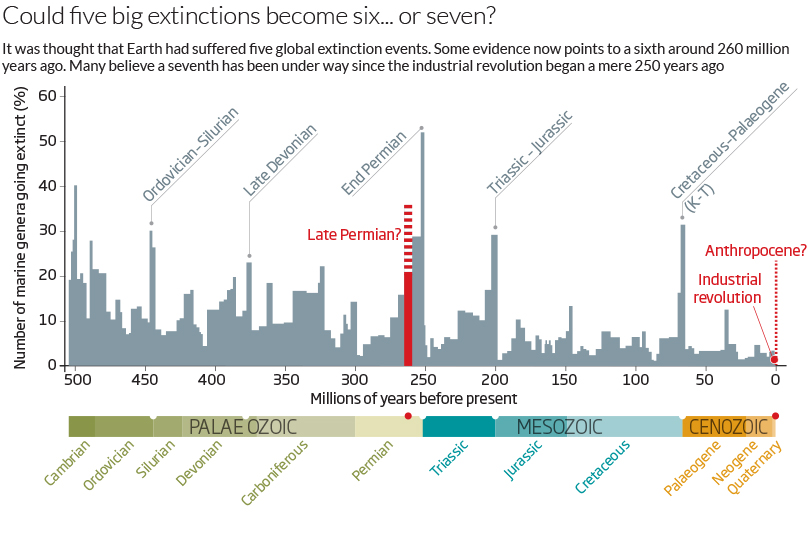 |
| Reviews and Templates for Expression We |
'Missing' disaster led to all-time worst extinction

THEY always get you when you're down. Life's biggest-ever disaster – the "great dying" 252 million years ago – was helped by another mass extinction just 8 million years before that.
If confirmed, it would mean that life in the Permian period was hit by a double whammy that made the extinction of the dinosaurs look like a tea party. This newly discovered second Permian extinction could have left ecosystems fatally vulnerable to the final knockout punch.
The great dying put paid to more than 90 per cent of all marine species as well as 70 per cent of land animals. It is widely considered the most comprehensive extinction event of all time, and the only one that caused mass extinction of insects. It marked the end of the Palaeozoic era, which had run for 288 million years, and seen the evolution of the first marine animals with hard shells, and the first land plants and animals.
Trilobites (bottom right of picture), which had thrived for 270 million years, were wiped out. Reptiles like the sail-backed dimetrodon and the massive dinocephalians disappeared, replaced by the reptile ancestors of dinosaurs, birds, pterosaurs, crocodiles – and mammals.
The first person to find evidence that Earth's history was punctuated by global extinctions was palaeontologist Jack Sepkoski, who studied species diversity across geological time.
As well as proposing a "big five" of mass extinction events, Sepkoski also found evidence of a smaller extinction peak slightly earlier in the Permian in marine organisms called foraminifera in what is now China. Although further evidence of extinctions around this time has been found, all of it was in the tropics, suggesting that the event was a regional, not global, affair.
But now David Bond of the University of Hull, UK, says there is evidence of a major marine extinction at the same time in the Arctic. Brachiopods – hard-shelled marine animals – left the most visible evidence of their demise. The fossil record Bond has uncovered in Spitsbergen, Norway, and in Greenland suggests that more than 50 per cent of all marine genera died during the event, with some groups losing 80 per cent of their genera. Ammonites and corals suffered heavily. Bond reported his findings on 19 October to the Geological Society of America meeting in Vancouver, Canada. "We can now say this is a real global mass extinction," he says.
Because, on a geological scale, these two Permian extinctions occurred so close together, species numbers might not have had time to recover from the first before the second began, says Bond, and so whole groups of organisms might have been fatally weakened. For example, three-quarters of trilobite genera went extinct in the earlier Permian extinction, leaving only five surviving genera that were then wiped out at the end of the Permian. In contrast, other mass extinctions have been separated by at least 50 million years (see chart).
There was a lot of volcanic activity in the late Permian, but how this translated into the extinction remains a matter of debate. Global warming caused by increased atmospheric carbon dioxide is a suspect, as is cooling from sulphur oxides and ash clouds, and ocean acidification in Arctic regions (Geological Society of America Special Papers, doi.org/wfg).
"Every mass extinction was the result of multiple factors, such as climate, sea level, anoxia and ocean acidification," says Gerta Keller of Princeton University, who has shown that eruptions in India were also a factor in the extinction of the dinosaurs.
Hit for six
Bond has now called for the earlier Permian event to be added to the "big five" mass extinctions that have so far hit Earth.
"Bond's ideas are reasonable," says Mike Benton of the University of Bristol, UK, "but nobody has yet provided a detailed and thorough estimate of the severity of the extinction so it can be evaluated against the big five."
Two earlier, independent counts of marine extinctions around the time of the earlier Permian event would place it as the third most severe extinction ever, with marine extinction rates of between 37 and 47 per cent, but a third study ranked it as tenth, with an extinction rate of 25 per cent. Different studies give different results for a variety of reasons, such as types of organism studied, and the accuracy of rock ageing, but Bond, who is also analysing Permian fossil data from Siberia, thinks his proposal will stand up. Keller says she would classify it as "a work in progress" as a potential sixth mass extinction.
As for the next big die-off, it is probably already under way, thanks to us. A working group set up by the International Commission on Stratigraphy (ICS) is pondering whether our current era should officially be named the Anthropocene, to reflect the profound impact of human activity. Keller, for one, is convinced by the extinction data coming in for modern species.
So too is ICS member Tony Barnosk of the University of California, Berkeley. "We are at the beginning of a sixth extinction," he says.
If further work proves Bond right, it is actually the seventh.
|
|
|
|
Copyright 2011 Energy and Technical Services Ltd. All Rights Reserved. Energyts.com |

